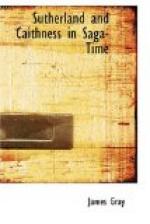The western islands of the Hebrides, however, still owed allegiance to the king of Norway, who was till 1240 engaged in civil war with Duke Skuli in his own kingdom. Alexander II therefore equipped a naval expedition to reduce the islands, but, soon after he had embarked, he sickened and died on the island of Kerrera, near Oban, in 1249, leaving as his successor, his son Alexander III, then only in his eighth year, who was married in 1251, before his eleventh year, to Margaret, daughter of Henry III of England, then a child of about the same age as himself. The marriage was followed by a nine years’ struggle between the rival factions of Alan Durward, Justiciar of Scotland, and of Walter Comyn, Earl of Menteith, in which England constantly interfered, till the Comyn, or Scottish, faction finally gained the upper hand. In 1261, Alexander III’s only child Margaret, who afterwards became Queen of Norway, was born.
Between 1242 and 1245 two Scottish bishops had been sent to Norway by Alexander II to induce King Hakon to give up the Hebrides to Scotland, and now his son Alexander III sent another embassy of an Archdeacon and a Scot, called in the Saga Misel, but more probably Frisel or Fraser, who, being found to be spies, tried to escape, but were caught and made to witness the young King Magnus’ coronation in his father’s lifetime.[3] These embassies, though backed by offers of money compensation, were wholly unsuccessful.
Meantime affairs in Sutherland and Caithness had been pursuing an orderly course for nearly forty years. William, eldest son of Hugo Freskyn, had succeeded his father in Sutherland before 1214, the year of Earl David’s death, and had in or after 1237 become its first Earl, and three years afterwards, according to tradition, though probably this event happened later, with the aid of Richard of Moray, Bishop Gilbert’s brother, a Norse landing at Unes or Little Ferry is said to have been repulsed in a battle at Embo, near Dornoch in Sutherland. In this battle Richard fell, and the Norse Prince was also killed, the Ri-Crois at Embo, which has disappeared long ago, being erected in memory of the latter.[4] Earl William had died in 1248, and had been buried in the Cathedral at Dornoch, which Bishop Gilbert had founded close to and west of the site of the older Church of St. Bar, and which he had dedicated to the Blessed Virgin Mary in or after 1222.
The Bishop had given to his diocese of Caithness[5] the Constitution which is still extant at Dunrobin. This Constitution, like that of Elgin, was in the main based on that of Lincoln. But the Bishop was to be Primus and above all other dignitaries of the Cathedral. For it was ordained that instead of the one priest who had previously officiated, there should be ten Canons with the Bishop as their head, five of them holding the dignities of Dean, Precentor, Chancellor, Treasurer, and Archdeacon, each of them during residence to minister there daily, as well




